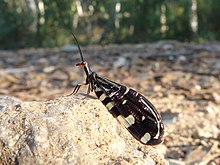Osmylidae
| Osmylidae | |
|---|---|
 |
|
|
Porismus strigatus, Black Mountain, Canberra (Australia) |
|
| Scientific classification | |
| Kingdom: | Animalia |
| Phylum: | Arthropoda |
| Class: | Insecta |
| Order: | Neuroptera |
| Family: |
Osmylidae Linnaeus, 1758 |
| Subfamilies | |
|
Eidoporisminae |
|
Eidoporisminae
Gumillinae
Kempyninae
Osmylinae
Porisminae
Spilosmylinae
Stenosmylinae
and see text
Osmylidae are a small family of winged insects of the net-winged insect order Neuroptera. The osmylids, also called giant lacewings, are found all over the world except in North America. A common species through most of Europe is Osmylus fulvicephalus.
Adult osmylids are small to moderately-sized net-winged insects, with wingspans ranging from 1.4 to 3 cm. Smaller members resemble typical green lacewings, and larger species resemble antlions. Many species, namely those of the type genus Osmylus, have spotted wings. The thin antennae are short. They have two compound eyes, as well as three ocelli in between. Adult osmylids, like green lacewings (colloquially known as "stinkflies"), have prothoracal glands which produce foul-smelling compounds used to deter would-be predators.
Their larvae are superficially similar to those of spongillaflies (Sisyridae). They have peculiar mouthparts which look like a thin forceps with the ends bending outwards. The body is elongated and slender and terminates in two extensible graspers bearing tiny hooks; these are used to aid in locomotion and to grasp prey. The larvae are associated with damp, mossy habitats and are amphibious. They hunt small invertebrate prey, from which they suck the body fluids with their mouthparts.
The adults are diurnal or crepuscular weak-flying insects which mostly prey on small invertebrates, supplemented with some pollen. Eggs are deposited in damp places, usually near freshwater.
...
Wikipedia
